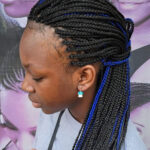African hair, which comes in various textures, lengths, and styles, is a monument to the beauty of diversity. Due to its distinctive qualities, maintaining its health and vigor might take a lot of work. Here, the age-old tradition of African hair braiding with a contemporary twist comes into play to improve appearance and support healthy hair.
A Rich Cultural Heritage
The plaiting or cornrowing of African hair is more than just a hairstyle. It’s a custom carried out inside the culture for many years. These complex designs and styles frequently have profound cultural importance and are used as a means of expression, storytelling, and cultural identity.
Protection and Versatility
One of its main advantages is that African hair braiding is protective. Close to the scalp, hair is tightly woven to form a protective barrier from the elements. This defense reduces the amount of hair deterioration brought on by exposure to the sun, wind, and pollution. Additionally, it lessens the need for chemical treatments and high levels of heat styling, which can weaken hair over time.
The hair braiding shop in Waxahachie, Texas, also offers stylistic flexibility—the options are unlimited, ranging from straightforward patterns to more complex ones. People can choose from various braid widths, lengths, and forms to create a distinctive look matching their fashion. This adaptability enables people to change their appearance without endangering the health of their hair.
Low Maintenance and Longevity
African hair braids require only modest daily grooming and require little upkeep. Less manipulation and a lower chance of hair breakage result from this. Braids can endure for several weeks with proper maintenance, giving the scalp and hair time to relax and repair. People can concentrate on moisturizing and nourishing their hair below the braids at this time to encourage general hair health.
Retaining Moisture
Retaining moisture is a problem that many people with African hair encounter. Brittleness and fracture can result from dryness. African hair braiding, however, preserves moisture. Before braiding, using protective oils and other items can improve moisture retention even more.
Hair Growth and Length Retention
African hair braiding encourages length preservation and hair development. Reduced style and manipulation regularly allow hair to develop without being constantly at risk of breaking. The ends of the hair, which are vulnerable to breakage and split ends, are also shielded by braids. People can reach their chosen hair objectives thanks to the conservation of hair length.
Scalp Health
The health of your hair as a whole depends on a healthy scalp. When done correctly, African hair braiding prevents the scalp from overloading with heavy extensions or tight braids that could hurt or harm it. Additionally, braiding promotes blood flow to the scalp, which may help create a better environment for hair follicles.
Cultural Expression and Pride
African hair braiding is a potent form of cultural expression, national pride, and its many practical advantages. Many consider it a way to honor their African ancestry and become closer to their roots. We at AAHB- a hair braiding shop in Arlington, Texas– cultivate a sense of self, self-assurance, and beauty that goes beyond outward appearance.
Maintaining Healthy Braids
African hair braiding has many advantages, but both the hair in the braids and the hair below must be taken care of. It’s essential to often moisturize the scalp and hair with natural oils and hair-friendly products. Damage can be avoided by not using too much strain when braiding and not leaving braids in for too long.
In conclusion, African hair braiding is a practice that is deeply ingrained in culture and history and is more than just a hairdo. Its protective and adaptable qualities support healthy hair by retaining moisture, lengthening hair, and promoting scalp health. People can honor their history while enhancing their beauty by adopting African hair braiding. African hair will always represent power, resiliency, and diversity because it is a timeless art form that is constantly changing.



